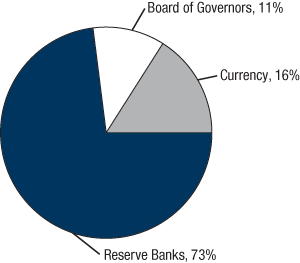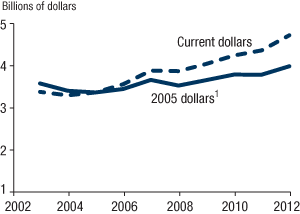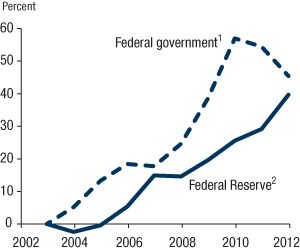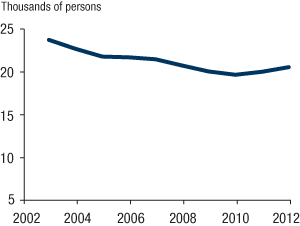Annual Report Budget Review 2012
Federal Reserve System Budget
Total expenses for the Federal Reserve System for 2012 are budgeted at $4,720.7 million, an increase of 8.2 percent from 2011 actual expenses. Of this total, $3,441.3 million is for the Reserve Banks, $532.4 million is for the Board and the Office of Inspector General (OIG), and $747.0 million is for the cost of new currency (table 2 and table 3). Revenue from priced services provided to depository institutions is expected to total $436.8 million, or 9.3 percent of total budgeted expenses. This revenue, combined with claims for reimbursement and other income, results in the recovery of approximately 20 percent of the System's budgeted 2012 expenses.8 When these items are deducted from budgeted expenses, 2012 net expenses for the System are 11.4 percent higher than 2011 net expenses (table 2).
| Item | 2010 (actual) | 2011 (actual) | 2012 (budgeted) | Percent change | |
|---|---|---|---|---|---|
| 2010 to 2011 | 2011 to 2012 | ||||
| Total System expenses1 | 4,243.3 | 4,363.6 | 4,720.7 | 2.8 | 8.2 |
| Less | |||||
| Revenue from priced services | 574.7 | 478.6 | 436.8 | -16.7 | -8.7 |
| Claims for reimbursement2 | 456.4 | 485.3 | 497.6 | 6.3 | 2.5 |
| Other income | 1.5 | 1.6 | 2.2 | 6.7 | 37.5 |
| Equals | |||||
| Net System expenses | 3,210.7 | 3,398.1 | 3,784.1 | 5.8 | 11.4 |
Note: Components may not sum to totals and may not yield percentages shown because of rounding. Total expenses reflect all redistributions for support and overhead and exclude capital outlays.
1. Includes expenses of the Office of Inspector General. Return to table
2. Reimbursable claims include the costs of fiscal agency and depository services provided to the U.S. Treasury, other government agencies, and other principals, to whom actual costs are billed and reimbursed by those entities. Return to table
| Item | 2010 (actual) | 2011 (actual) | 2012 (budgeted) | Percent change | |
|---|---|---|---|---|---|
| 2010 to 2011 | 2011 to 2012 | ||||
| Reserve Banks 1 | 3,183.0 | 3,261.3 | 3,441.3 | 2.5 | 5.5 |
| Personnel | 2,211.8 | 2,317.2 | 2,454.7 | 4.8 | 5.9 |
| Nonpersonnel | 971.2 | 944.1 | 986.6 | -2.8 | 4.5 |
| Board of Governors 2 | 437.4 | 452.3 | 532.4 | 3.4 | 17.7 |
| Personnel | 325.0 | 333.1 | 373.1 | 2.5 | 12.0 |
| Nonpersonnel | 112.4 | 119.2 | 159.3 | 6.0 | 33.6 |
| Currency 3 | 622.9 | 650.0 | 747.0 | 4.4 | 14.9 |
| Total System expenses | 4,243.3 | 4,363.6 | 4,720.7 | 2.8 | 8.2 |
Note: Components may not sum to totals and may not yield percentages shown because of rounding.
1. Excludes capital outlays and pension expenses as well as assessments for the Board of Governors operating expenses, currency costs, the Consumer Financial Protection Bureau, and the Office of Financial Research. Includes expenses budgeted by Federal Reserve Information Technology and the System's Office of Employee Benefits that are chargeable to the Reserve Banks. Reflects all redistributions for support and allocations for overhead. For detailed information on Reserve Bank expenses, see the "Federal Reserve Bank Budgets" section. Return to table
2. Includes expenses of the Office of Inspector General. See also the "Board of Governors Budgets" section. Return to table
3. For more information on currency expenses, see the "Currency Budget" section. Return to table

The distribution of budgeted expenses is similar to that in previous years, with the Reserve Banks' expenses accounting for 73 percent of the total, new currency expenses accounting for 16 percent, and Board expenses accounting for the remainder (figure 1).
System employment is budgeted at 20,544 for 2012, an increase of 528 from the 2011 level, primarily due to planned staff additions needed to implement requirements under the Dodd-Frank Act.9
2012 System Budget Initiatives
The Federal Reserve System budget is funding increases for several initiatives, specifically in supervision to promote financial stability and to continue to implement the Dodd-Frank Act, as well as in support of application development projects for Treasury and financial services. The major factors affecting the 2012 Board and Reserve Bank budgets are outlined in more detail in the "Board of Governors Budgets" section and "Federal Reserve Bank Budgets" section, respectively.
Trends in Expenses and Employment
From the actual 2003 level to the budgeted 2012 amount, the total expenses of the Federal Reserve System have increased an average of 3.8 percent per year (1.2 percent per year when adjusted for inflation) (figure 2). Over the same period, nondefense discretionary spending by the federal government has increased an average of 4.2 percent per year (figure 3). Over the 2003-2012 period, Federal Reserve System employment has decreased by 3,183 (figure 4).

Note: For 2012, budgeted. Includes expenses of the Office of Inspector General.
1 Calculated with the GDP price deflator.

Note: For 2012, budgeted. Federal government expenses are reported on a fiscal-year basis beginning October 1; the Federal Reserve System expenses are reported on a calendar-year basis.
1 Discretionary spending less expenditures on defense. Source: Budget of the United States Government, Fiscal Year 2013: Historical Tables, Table 8.1. Outlays by Budget Enforcement Act Category, 1962-2017.
2 Includes expenses of the Office of Inspector General.
The most recent budgets reflect increases for resources to address requirements under the Dodd-Frank Act. In addition, budgets also included funding to address the financial market turmoil and deteriorating economic conditions. Reserve Bank expenses associated with these programs peaked in 2010 and have since declined, as liquidity programs wind down.10 These increases have been offset by substantial expense and staffing decreases due to restructuring efforts in the check processing function and staff declines and related expenses due to efficiency measures in cash operations and support functions.

Note: For 2012, budgeted. Employment numbers presented include position counts for the Board and average number of personnel for the Reserve Banks.
2012 Capital Budgets
The capital budgets for the Reserve Banks and the Board total $444.9 million, with $404.2 million budgeted for the Reserve Banks, Federal Reserve Information Technology (FRIT), and Office of Employee Benefits (OEB) and $40.7 million budgeted for the Board and the OIG. As in previous years, the 2012 capital budgets include funding for projects that support the strategic direction outlined by the individual Reserve Banks, System business leaders, and the Board. These strategic goals focus on investments that continue to improve operational efficiencies, enhance services to Bank customers, and ensure a safe and productive work environment. More detailed discussions of the Board and Reserve Bank capital budgets are included in the "Board of Governors Budgets" section and the "Federal Reserve Bank Budgets" section.
References
8. Claims for reimbursement refers to the costs of fiscal agency and depository services provided to the U.S. Treasury, other government agencies, and other principals, to whom actual costs are billed and reimbursed by those entities. Other income is the fee that depository institutions pay for the settlement component of the Fedwire Security Service transactions. In addition, a further portion of the System's expenses since July 21, 2011, related to carrying out supervisory and regulatory responsibilities for large financial institutions will be recouped in accordance with the Dodd-Frank Act. Return to text
9. Employment numbers stated include position counts for the Board and average number of personnel (ANP) for the Reserve Banks. ANP is the average number of employees expressed in terms of full-time positions for the period. For instance, a full-time employee who works one-half of the year counts as 0.5 ANP for that calendar year; two half-time employees who work the full year count as 1 ANP. Return to text
10. Expenses associated with the remaining programs will continue to diminish, but this decrease will be dependent on continued activity, especially for the Maiden Lane facilities. In addition, the higher expenses reflect an increase in activities related to assessing value and margining collateral pledged to the Reserve Banks and steps that the New York Bank, in particular, took structurally to manage its risk more effectively. These expenses are not likely to decrease over time and reflect additional ongoing activities. Return to text
